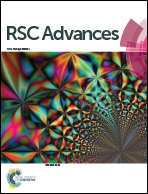Facile synthesis of well-dispersed CeO2–CuOx composite hollow spheres with superior catalytic activity for CO oxidation†
Abstract
Well-dispersed CeO2–CuOx composite hollow spheres have been successfully synthesized through a facile reflux method using carbon spheres as sacrificial templates. The shells of the hollow spheres, ∼40 nm in thickness, consist of self-assembled 10–15 nm sized nanoparticles. Scanning electron microscopy (SEM) and transmission electron microscopy (TEM) were employed to study the structural features of the CeO2–CuOx composite hollow spheres. X-ray photoelectron spectroscopy (XPS) confirmed that most of the copper element is distributed on the surface of the CeO2 shell support. The CeO2–CuOx composite hollow spheres exhibited enhanced catalytic activity for CO oxidation: complete CO conversion could be obtained at 112 °C. The excellent catalytic activity could be ascribed to the hollow structure, high specific surface area and the strong synergistic interaction between CeO2 and CuOx.


 Please wait while we load your content...
Please wait while we load your content...